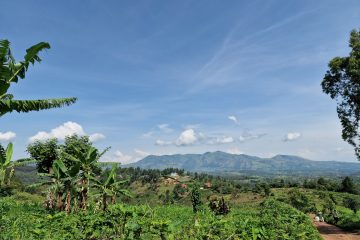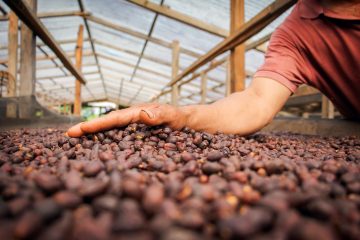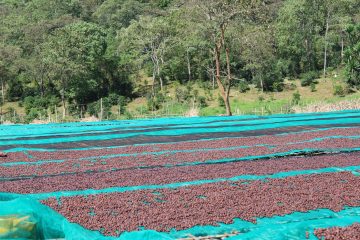
My trips to Burundi the last two years visiting producers and cupping through loads of their coffees from different washing stations have convinced me. The quality and flavor potential is great! With a pretty diverse range from mature dark fruit flavors to complex citrus, current and stone fruit nuances I am sure we will be able to source some of the finest and most interesting coffees from the region. Even if they started with coffee generations ago it’s recent that they opened the possibility of direct contracts, and again this makes it easier to separate and select the finest coffees. The infrastructure, milling and export is still challenging, and being present during and post harvest is of major importance to source the best coffees and get them milled and shipped efficiently. We will follow up certain washing stations, monitor the process and cup daily lots from the peak of harvest to select and ensure the preferred qualities.General information
Burundi is a small landlocked country bordering Rwanda in the north, Tanzania to the southeast and Lake Tanganyika and Congo to the west. The country have about 10 million citizens, where of 600 000 is coffee farmers. Coffee and tea is the two main export commodities. Wikipedia Burundi information
The Belgians introduced coffee in the 1930’s. After the independence in 1962 the coffee sector was totally private until 1976, when it all became state owned. From 1980 – 1993 they invested in the coffee sector with help from the World Bank. They increased the number of trees from 90 millions to 220 millions and built 133 coffee washing stations around the country to produce fully washed coffees. After pressure from The World Bank they have been forced to undergo privatization and now after years of civil war the industry is liberalized and the government is selling out washing stations as well as privates are investing in the industry constructing new processing units. They opened for direct sales contracts in 2008 to target the specialty coffee industry. Today there is about 160 washing stations around where of approximately 30 is private. For more info visit Cafe du Burundi.

Growing conditions and production
Despite a lot of deforestation Burundi is still fertile. With volcanic soils, a rainfall of 1300 mm pr year the growing conditions are good. Still, to increase yield they need soil treatment, and working with proper organic fertilizer such as compost can more than double the average yield from 2 to 5 kg’s pr tree. The predominant variety is Bourbon and the coffee is mainly cultivated at altitudes from 1300 – 2000 meters above sea level.
In a good year they should be able to produce about 30 000 MT. As well as there is a natural cycle of high and low production every second year they have been struggling lately with low yield. This year they produced about 7000 tons fully washed and 7000 tons washed (small-holder coffee) of poor quality.
Coffee regions
There are 14 coffee growing regions, where 7 of them are of bigger importance regarding numbers of washing stations. The ones of most importance is Ngozi, Kayanza, Gitega, Muyinga, Kirundo, Karuzi, Bubanza. Check out Burundi region map and soil overview


Sogestals
Each coffee province of importance is organized with a Sogestal that’s state owned or owned by a mix of private investors and the government. The Sogestals with private investors are known to be more structured with ability to increase quality and efficiency. The Sogestals are representing the state owned washing stations and operates more or less as a service provider and marketing agent for the coffees. The largest Sogestals like Kayanza can represent up to 19 washing stations. Each washing station can have up to several thousands of small holders delivering cherries.
There are several private washing stations around as well and a lot of entrepreneurs. They do have a lot of potential as well, but despite the politics it still seems like the washing stations under the Sogestals are producing some of the best coffees and have more professional management at the production level. Still it’s interesting to follow up the privates as they have willingness to custom and adjust their chain of operations towards quality.
Cherry reception
The main harvest will start in March, peak around April/May (depending on altitude and weather) and end in June. Some washing stations have pretty strict routines for cherry reception. The coffees are sorted by the farmers at the receiving stations on raised tables, or they even have small flotation tank system for each farmer at delivery. They will then skim off the floaters and give it back to the farmer before the coffees are hand sorted to separate unripe/halfripes.

Fermentation, washing and drying
The traditional fermentation and washing process in Burundi is a lengthy procedure with double fermentation and soaking. They normally use traditional disc pulpers and then dry ferment for 12 hours, wet fermentation for up to 24 hours before washing and soaking for 12 – 18 hours in clean water. From there it goes to pre drying under shade with handpicking of wet parchment before entering the elevated and sun exposed drying tables. The double fermentation is a labor dense process that requires a lot of water. Some supportive coffee programs has suggested and initiated a 12 hour dry fermentation time before 12-18 hours soaking time in clean water to reduce labor, increase capacity and avoid overfermentation and risk during the process.
Parchment
After drying the parchment is stored in local warehouses. There is a great number of washing stations that separate daily lots tagged with all the information needed for full trace ability. The coffees are then trace able back to cherry delivery for each and every farmer. Cupping through several daily lots from different washing stations proves that the differences are huge. Accordingly to where the cherries comes from, how the conditions are during process and drying, ripeness of cherries and of course awareness during chain of operations will affect the quality and cup profile. Even from a washing station with great potential the only way to get true quality is to be present in Burundi at the right time and select the daily lots and separate or blend them based on the cup profile.

Milling and export
There is not to many providers to choose from at the moment, but there is a lot of progress and development going on. We still have several options and with close follow up we will manage to get the coffees milled separately, handpicked for defects according to our instructions and get coffees out of there emediently after the harvest, starting 2012. It will all be in grainpro to ensure and maintain quality and shelf life. The standard A – grade is 16 up, with acceptance of 25% lower bean size but we will be able to do higher gradings as well. Most of the dry mills are geared to do large volumes of commercial coffees, and struggle with separation of medium lot sizes of high and small batches and micro lots, but there are options available.


